You are here
The Global Feminization of Migration: Past, Present, and Future

Group of young women standing near bus before migrating to Australia. (Photo: Australian National Maritime Museum)
Scholars have declared feminization to be a core dimension of the new age of international migration and globalization. In one sense this is accurate: between 1960 and 2015, the number of female migrants doubled. But so did the number of male migrants and the size of the earth’s population. As a proportion of international migrants, by contrast, the female share increased only slightly from 46.6 percent in 1960 to 48 percent in 2015. Examination of global patterns of migration over the centuries leads to a more nuanced understanding of the meaning of feminization, and suggests that scholars failed to notice a substantial uptick in female migration that occurred well before 1960. Such analysis demonstrates that women have always migrated, often in substantial numbers. The greater challenge facing migration researchers is to understand the causes and consequences of the migration gender balance, which shifts over time and varies considerably across cultures and nations.
The Feminization of Migration Goes Global
For more than four centuries, women have been part of global migration flows. During the early period of European empire-building, many migrants were coerced labor and not universally male. The gender composition of African forced (or coerced) migrants varied over time (see Figure 1). Although the representation of men increased over the course of the Atlantic slave trade, the presence of women varied considerably by destination and sending region. Among the most extreme variations over time was the drop from 70.4 percent female in 1546 to just 6 percent in 1548.
Figure 1. Female Share of Slave Trade Embarkations, 1532-1864
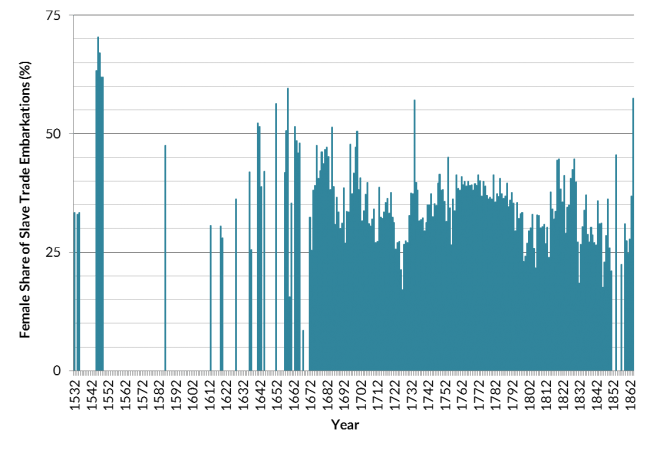
Note: This figure combines all data about the sex of African forced migrants on voyages recorded in the Transatlantic Slave Trade Database.
Source: Transatlantic Slave Trade Database, “List of voyages,” available online, data compiled and accessed by authors in 2012 and first published in Katharine M. Donato and Donna Gabaccia, Gender and International Migration (New York: Russell Sage Foundation, 2015).
In the 19th and early 20th centuries, international migrants were largely settler colonizers and wage earners. In both groups men were often the first to migrate, with women following as colonies grew. While the earlier movement of settler colonizers was relatively gender balanced, between 1840 and 1924 global labor migrations became heavily male and circulatory as empires grew and increasing levels of international trade demanded temporary male workers to build infrastructure and work on plantations and in heavy industry. Figure 2 shows the gender composition of global emigration flows during this time. Women made up between 20 percent and 40 percent of emigrants, except in 1874 and 1875 when they represented about half of the outflows.
Figure 2. Global Emigration Totals and Female Share, 1840-1924
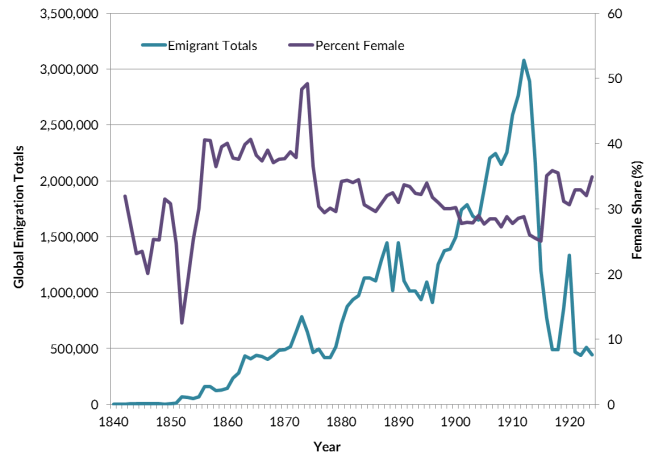
Source: Authors’ compilation, first published in Donato and Gabaccia, Gender and International Migration (New York: Russell Sage Foundation, 2015), based on data from Walter F. Willcox and Imre Ferenczi, eds., International Migrations Volume 1: Statistics (New York: National Bureau of Economic Research, 1929), available online.
Beginning in the mid-1920s, increased regulation of immigration in many countries pushed global migrations toward gender balance. As national laws increasingly restricted male-dominated labor migration, women and families became a larger share of the immigrant population. This increase in the female share of global migrant flows thus resulted as much from the control of male labor migrants as from the number of women moving primarily to developed nations, such as the United States, as spouses of U.S. citizens, refugees, and other non-labor migrants. By the first decade of the 21st century, gender balance characterized many migrations worldwide. Figure 3 shows, for example, that among the world’s foreign born, women consistently represented 47 percent to 48 percent of international migrants between 1960 and 2010.
Figure 3. Estimates of the Gender Composition of Global Migrant Populations for 66 Selected Countries (ages 18 and older), 1960-2010
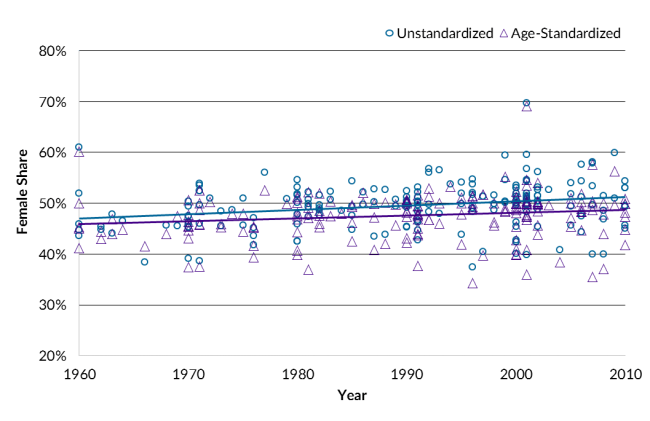
Note: The two lines represent the standardized and unstandardized estimates of gender composition. The standardized estimates control for differences in expected lifespan between sexes in populations over time and are more conservative than the unstandardized estimates.
Source: Authors’ compilation, first published in Donato and Gabaccia, Gender and International Migration (New York: Russell Sage Foundation, 2015), based on data from the Integrated Public Use Microdata Series (IPUMS) International at the Minnesota Population Center, University of Minnesota.
Feminization: Not a Recent Development
In 1984, U.S. Labor Department demographers published data in the International Migration Review (IMR) showing women represented 52.3 percent of recent immigrants to the United States. In the same IMR special issue, the journal’s first to focus on migrant women, sociologist Saskia Sassen-Koob explored the feminization of the workforce in small-scale agriculture areas characterized by male migration, in global assembly plants in Asia, and in wealthy nations seeking foreign women as domestic laborers. Less than a year later, The New York Times ran an article entitled “Men Only a Third of U.S. Immigrants,” suggesting that fewer immigrants would be entering the labor market as the proportion of migrants who were women and children rose. Then, approximately a decade later, social scientists Stephen Castles and Mark Miller further spread the idea of feminization of migration, making it a defining global pattern in their widely read book, The Age of Migration.
This flurry of scholarly attention continues in the study of how gender shapes different dimensions of migration. But as shown above, feminization is not a recent development—the biggest shifts toward gender balance occurred before 1960—and the global migration of women and girls has a very long history.
The United States, as a paradigmatic nation of immigrants, offers a useful example. The U.S. census data presented in Figure 4 show the percentage of women in the U.S. immigrant population between 1850 and 2010, and suggest that gender dynamics in immigration were more volatile before 1930 than afterward. Figure 4 also suggests that the increasing share of women among U.S. immigrants in the 20th century may have been associated with shifts in the absolute number of the foreign born, although other explanations such as shifts in labor demand and the influence of emigration and admission policies merit further research. Prior to 1960, for example, the female share rose while the number of immigrants fell; afterward, women’s representation rose as the number of U.S. immigrants also increased. After 1970, however, shifts in the female share were small and the population was largely gender balanced, despite a substantial rise in the overall number of immigrants. This changing relationship between the volume and gender composition of the U.S. immigrant population is the most significant characteristic of recent, yet modest, levels of feminization.
Figure 4. Gender Composition of U.S. Immigrants, 1850-2010
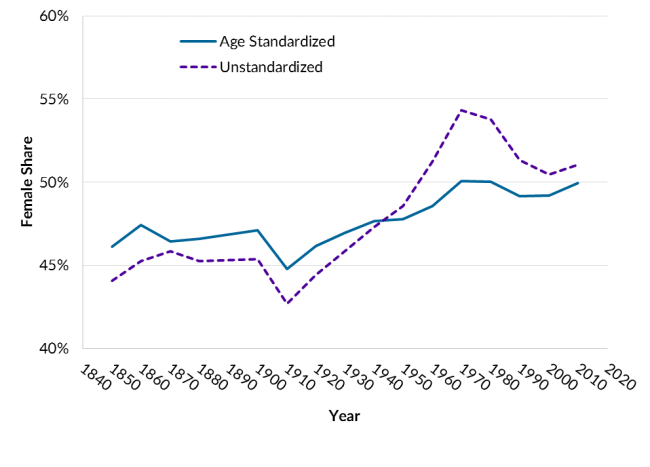
Note: The standardized estimates control for differences in expected lifespan between sexes in populations over time and are more conservative than the unstandardized estimates.
Source: Authors’ compilation, first published in Donato and Gabaccia, Gender and International Migration (New York: Russell Sage Foundation, 2015), of data from the Integrated Public Use Microdata Series (IPUMS) at the Minnesota Population Center, University of Minnesota.
So why did the significant number of women and girls among international migrants before the 1960s go unnoticed for so long? And why, then, did small upward shifts in the presence of women attract so much attention? The answer lies in how evidence is produced and how researchers and statisticians collected the data and constructed the categories that measure the relative numbers of female and male migrants. These practices have resulted in vague definitions of feminization and have obscured important variations in migrant gender composition.
Ambiguous Definitions
Feminization, when used in the context of migration, has been defined in many ways. Some scholars used the term to refer to rising numbers of women migrants between two years or time periods, to describe recent shifts in women’s roles or prominence in migrant populations, or to highlight increasing shares of women among all migrants. Scholars in different disciplines also measure feminization differently. While many sociologists often use sex ratios to capture granular variations, historians prefer “percent female” as a way to describe shifts in gender composition over long periods of time.
Yet understanding the causes and consequences of differing migration patterns among men and women requires a careful, not vague, definition of feminization. Consider the following: Comparing migrant gender composition in 2015 to that in 1960 yields just a 1.4 percentage point increase over a 45-year period. However, this move toward gender balance appears much more robust if 2005 is compared to 1900, when global demand for male labor migrants was nearing its peak. Thus, comparisons over a longer history and larger geographic scale are necessary to understand, for example, when and why a shift toward global gender balance began.
Obscured Variations and Their Causes
The balance of men and women among international migrants varies not just across time but also across world regions and individual countries. Table 1 shows, for example, that during the period of early forced migration between Africa and the Americas, some African regions sent populations that were more male-predominant than those from other regions. In an important counterpoint to early migration research, these data suggest that sellers and purchasers of slaves were not exclusively concerned with (male) migrants as forms of productive labor. Instead, they viewed women and girls as valuable for their reproductive capacity, which promised to strengthen lineage groups and slave workforces.
Table 1. Share of Female Forced Migrants Exported and Imported by Region, 1532-1864
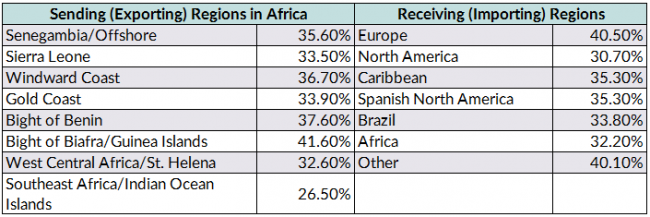
Source: Authors’ compilation based on Transatlantic Slave Trade Database, “List of voyages,” accessed in 2012.
Spatial variation in the gender composition of contemporary global migrant populations is also significant. In 1960 the foreign-born population in the Netherlands was 61 percent female, in 2001 in Nepal it was 70 percent female, and more recently in South Africa it was approximately 35 percent. Underlying these variations are patterns and shifts in gender relations and ideologies that increasingly operate on a global scale. The distinctly female-predominant immigrant population in the Netherlands was driven both by the decolonization of Indonesia and Suriname, which motivated return migration among Dutch expatriates (many of them with Indonesian or Surinamese brides), and by a mid-20th century influx of female-predominant World War II refugees. The high proportion of women among migrants in Nepal reflects marriage migration practices in South Asia and the free movement of people between Nepal and India since 1950. The smaller share of women in South Africa reflects a longstanding tradition of male circular labor migration in the region which, until recently, was largely driven by employment in mineral mining and extraction, for global export markets.
And the Consequences?
Although some scholars have examined how migrant gender composition affects labor force participation, marriage formation, racial differences in family structure, and cultural responses to migration, this work is relatively new and overwhelmingly considers the consequences of the gender composition for migrants after 1990. Moreover, most of these studies describe the substantial negative effects of male-predominant, not female-predominant, migrant populations, associating the predominance of men to political instability, high levels of violence, and the mistreatment of women.
Though limited to the United States by the availability of long-term data, a closer look at the past century suggests modest effects, at best, of changing migrant gender composition. On the one hand, the characteristics of U.S.-born women and men and their foreign-born counterparts have converged since 1910. On the other, persistent but small differences can be seen in the labor force participation rates of specific national-origin groups that have had relatively more migrant men or women. Clearer signs of convergence in labor market activity between 1960 and 2010 appear in Figure 5, with the rates of both foreign-born women (Panel A) and men (Panel B) nearing those of their U.S.-born counterparts. For women, upward shifts reflect the growth in employment for married women; for men the downward shift occurred among married and unmarried and among both foreign and U.S. born.
Figure 5. Predicted Probabilities of Being in Labor Force by Nativity and Gender, 1960-2010
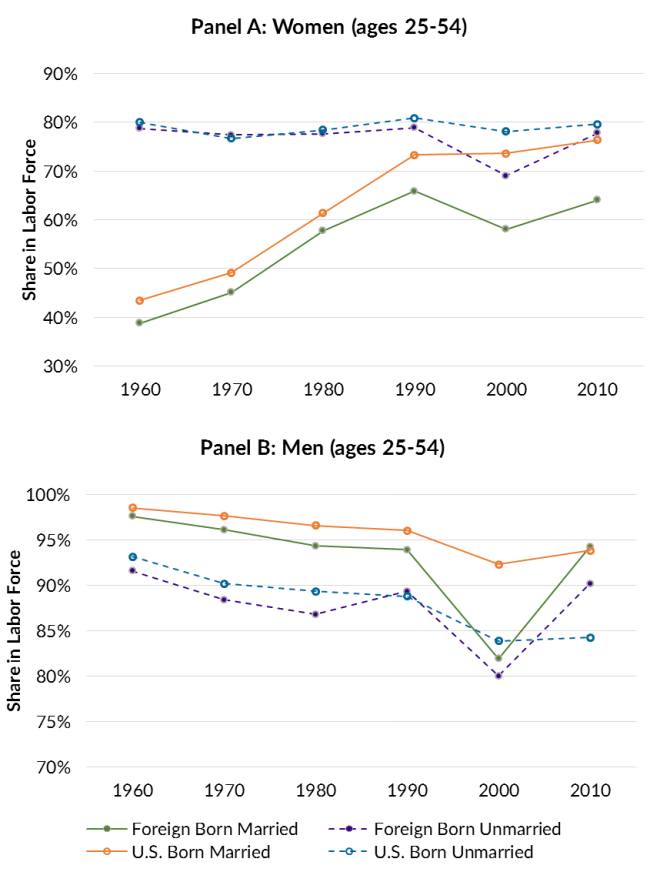
Note: Analysis restricted to those ages 25-54.
Source: Authors’ compilation, first published in Donato and Gabaccia, Gender and International Migration (New York: Russell Sage Foundation, 2015), of data from the Integrated Public Use Microdata Series (IPUMS) at the Minnesota Population Center, University of Minnesota.
Finally, an examination of marriage patterns in the United States by the authors shows that although there were more marriages between foreign- and U.S.-born individuals in the period between 1970 and 2010, this increase was largely driven by the growth of the total immigrant population across the 20th century. After 1970, interethnic cross-nativity marriages actually declined, as many newcomers married the U.S.-born descendants of earlier immigrant groups.
Where Does the Discussion of “Feminization” Go from Here?
By looking at the shifting gender composition of migrant flows and immigrant populations through a historical and global lens, it becomes readily apparent that there are important patterns and variations not accounted for in the contemporary debate over the feminization of migration. In addition to the utility of looking at seemingly recent trends over a longer period of time, the authors propose a shift in terminology: The typology distinguishes between routine and predictable variations in gender composition and more substantial increases or decreases in the female share of migration likely caused by evolving gender relations, labor market roles, and ideology. The authors use the terms “heavy,” “predominant,” and “gender balanced” to describe populations with higher or lower shares of women, creating the spectrum described in Table 2.
Table 2. Typology for Describing the Female Share of a Population
Source: Donato and Gabaccia, Gender and International Migration (New York: Russell Sage Foundation, 2015).
These definitions permit more concrete description of the feminization and masculinization a population is experiencing, by shifting from one category to another (e.g. from heavily male to male predominant). In addition, these more narrow definitions allow for consideration of potential consequences of the gender composition for migrants, their homelands, or the societies they enter. Together, they suggest that careful interrogation of data and how they are used matter for studies of gender and migration.
As future research continues to rely on a patchwork of data sources, migration researchers should insure that the insights their work offers do not render some groups of people, such as women or children, invisible. They also should query the underlying perspectives that datasets and measurements produce to better appreciate the fluidity of gender composition.
Acknowledgments
This article draws significantly from the authors’ book, Gender and International Migration. published in 2015 by the Russell Sage Foundation.
Sources
Bilsborrow, Richard E. and Hania Zlotnik. 1992. Preliminary Report of the United Nations Expert Group Meeting on the Feminization of Internal Migration. International Migration Review 26 (1): 138-61.
Castles, Stephen and Mark J. Miller. 1993. The Age of Migration: International Population Movements in the Modern World. New York: Guilford Press.
Donato, Katharine M., J. Trent Alexander, Donna Gabaccia, and Johanna Leinonen. 2011. Variations in the Gender Composition of Immigrant Populations: How and Why They Matter. International Migration Review 45 (3): 495–525.
Donato, Katharine M. and Donna Gabaccia. 2015. Gender and International Migration. New York: Russell Sage Foundation.
Donato, Katharine M., Donna Gabaccia, Jennifer Holdaway, Martin Manalansan IV, and Patricia R. Pessar. 2006. A Glass Half Full? Gender in Migration Studies. International Migration Review 40 (1): 3-26.
Gabaccia, Donna R. 1996. Women of the Mass Migrations: From Minority to Majority, 1820- 1930. In European Migrants: Global and Local Perspectives, eds. David Hoerder and L. Moch. Boston: Northeastern University Press.
Gabaccia, Donna R. 2014. Time and Temporality in Migration Studies. In Migration Theory: Talking Across Disciplines, 3rd edition, eds. Caroline Brettell and James Hollifield. New York: Routledge.
Gabaccia, Donna R. and Elizabeth Zanoni. 2012. Transition in Gender Ratios among International Migrants, 1820-1930. Social Science History 36 (2): 197-222.
Houstoun, Marion F., Roger J. Kramer, and Joan Mackin Barrett. 1984. Female Predominance of Immigration to the U.S. International Migration Review 18 (4): 908-63.
Lucassen, Leo. 2005. The Immigrant Threat. Champaign, IL: University of Illinois Press.
Muus, Philip. 2004. The Netherlands: A Pragmatic Approach to Economic Needs and Humanitarian Considerations. In Controlling Immigration: A Global Perspective, ed. Wayne A. Cornelius. Stanford, CA: Stanford University Press.
Pear, Robert. 1985. Men Only a Third of U.S. Immigrants. New York Times, September 9, 1985. Available Online.
Ravenstein, E.G. 1885. The Laws of Migration. Journal of the Statistical Society of London 48 (2): 167-235.
Sassen-Koob, Saskia. 1984. Notes on the Incorporation of Third World Women into Wage-Labor through Immigration and Off-shore Production. International Migration Review 18 (4): 1144-67.
United Nations. 2016. International Migration Report: Highlights. New York: Department of Economic and Social Affairs. Available Online.
van Amersfoort, Hans. 2011. How the Dutch Government Stimulated the Unwanted Immigration from Suriname. International Migration Institute working paper 47, University of Oxford, October 2011. Available Online.
Willcox, Walter F. and Imre Ferenczi, eds. 1929. International Migrations Volume 1: Statistics. New York: National Bureau of Economic Research. Available Online.
Zlotnick, Hania. 1990. International Migration Policies and the Status of Female Migrants. International Migration Review 24 (2): 372-81.
---. 2003. The Global Dimensions of Female Migration. Migration Information Source, March 1, 2003. Available Online.


